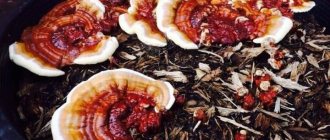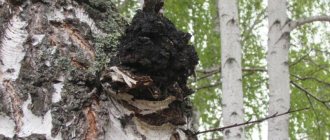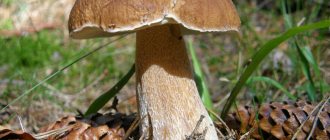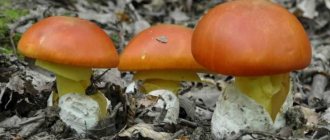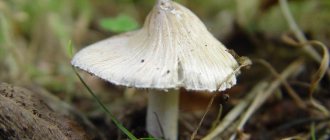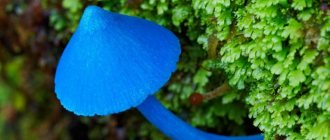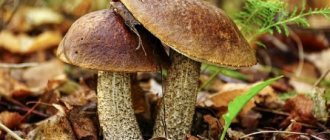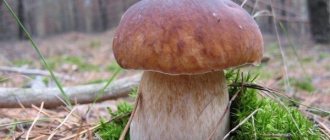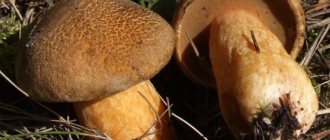Canine mutinus (lat. Mutinus caninus) is a representative of the Veselkov family. It is edible if there is a shell around it, although it has an unpleasant odor. The mushroom is rare, therefore it is listed in the Red Book. The mushroom was first found by a scientist living in Great Britain, and then Mutinus canis and Ravenel were considered the same species. Later they began to be distinguished by a number of characteristics.
This fungus is a saprophyte - it can feed on organic decaying food and live without “cooperation” with plants, and therefore it can grow in places where there are a lot of remains of such food.
What does mutinus canine look like?
When the mushroom is not ripe, but is just developing, it is covered with a special shell, which ensures the development of spores and the body of the mushroom. At first, its dimensions range from 3 to 4 centimeters. The shell is usually white or pinkish in color, can grow up to 16-18 cm and, moreover, have a small diameter. When the mushroom matures, this shell bursts, and then spores begin to ripen, which are carried by flies. The stem of the mushroom is cylindrical in shape, which has a sharp tip. Sometimes you can find specimens with a 12-centimeter stem with a thickness of about a centimeter.
The mushroom itself is hollow and its structure is spongy. Mutinus is usually pink in color, but can have an orange tint. Its top is pale pink, and the mushroom has no cap at all - it is replaced by a special mucus that has a terrible smell.
Morel
Morels are one of the earliest mushrooms. They may begin to appear as early as April. In Russia there are 5 species of them. The mushroom is rich in vitamins such as vitamin A, vitamins B1 and B2, vitamin C. In addition, it contains a lot of calcium and phosphorus. In Rus', morels have always been used to treat vision problems. So in the chronicles there is a mention that with the help of Morel juice, Yaroslav the Wise was cured of cataracts. The mushroom also copes well with myopia, age-related farsightedness, and inflammation of the eyelids. The complex of polysaccharides and microelements that make up the mushroom can strengthen the eye muscles and protect the eye lens from clouding. The first studies of these properties of Morel began back in the 50s in Czechoslovakia. Later they were studied in France and the USSR. Everywhere the results were very impressive, although one peculiarity emerged - during the course of the Morel medicine, you cannot take antibiotics, because they reduce its effectiveness.
Morel also improves appetite and normalizes the activity of the gastrointestinal tract.
Where does it grow
Mutinus canis grows both in the warm regions of Russia, such as the Krasnodar region, and in the Murmansk region. You can also find the mushroom in Primorye. It also grows in Ukraine, Armenia and Georgia. Sometimes it is found in North America. Usually mushrooms do not live alone; they can be found in damp places and near stumps. It mainly grows in forests where the soil is rich in humus. It also likes to grow on rotting wood or sawdust.
It bears fruit from mid-summer to September, prefers soil with fertilizers that are in the garden or next to the bush. After the flies eat the mucus around it, the mushroom dies within a few days, but before that it turns orange.
Amethyst bulb
Photo: www.funghiitaliani.it
Great luck for connoisseurs of the wonders of nature comes across this purple mushroom. It grows in deciduous and coniferous forests of all continents, not counting Australia and Antarctica.
Young mushrooms have a rich purple color, which gradually fades. Initially, the mushroom cap is spherical, after which over time it turns into a flat one. Many people call the mushroom a “deceiver”, since it is not easy to recognize.
Although an edible mushroom, it is still fraught with danger. If there are poisons in the growing soil, then the mushroom tends to accumulate them.
The nature of our planet is multifaceted and amazing. Many living organisms and substances have not yet been studied. Discoveries are happening and will continue to happen, disturbing great minds. Let's not remain indifferent and continue to contemplate the wonders of nature together.
Doubles
The most important double can be called Mutinus Ravenel. The latter mushroom can be distinguished by its bright body with a yellowish tint and the smooth white shell of the young mushroom. These species are edible until fully ripe, so if you confuse them, nothing bad will happen. Both Mutinus are quite rare in the forest and are listed in the Red Book on the territory of the Russian Federation.
Mutinus Ravenel
Another double of the mushroom can be called the white toadstool. This is a poisonous mushroom that can cause poisoning. You can distinguish it by its almost transparent egg, through which you can see how the cap is born.
White grebe
Mutinus canis can also be confused with the common moth. This mushroom has a beige egg and the mucus is dirty yellow. Under the mucus you can see the white body of the mushroom.
Veselka vulgaris
Milky blue
Photo: nibler.ru
The purple mushroom grows in mixed forests of East Asia, North and Central America. It belongs to the Russula family. Has a brittle structure.
When broken, a blue milk flows out of the body of the mushroom, which is how it got its name. Despite its unusual coloring, it is edible. It is often on sale in places where it grows.
Medicinal properties
This mushroom is actively used in folk medicine. It is used for gout, and the juice of the immature mutinus is used to create face masks. Mushrooms of this type are good for rejuvenation and, as some healers say, can help fight cancer (but this, of course, is unverified information) . Mutinus canis can also help boost immunity. So, it contains tannin and alkaloids. It is also known that a decoction of this mushroom helps to recharge and invigorate.
Usually, mushrooms are doused with alcohol or vodka and left for several days in a cool place and used as an ointment for joints.
But despite this, you can be poisoned by this mushroom. During the development period, it absorbs heavy metals such as copper and iron, so the danger exists. In case of poisoning, a headache may begin, blood pressure may drop, and pain may appear in the stomach.
Virulence
The mutinus canis mushroom is poisonous. In the egg stage, it can easily be confused with the edible fungus, which is why cases of poisoning sometimes occur.
They absorb many toxins, heavy metal salts and copper isotopes. The first symptoms of poisoning appear at different times. It depends on the individual characteristics of the organism.
Symptoms of poisoning
Symptoms of poisoning appear 2-3 hours after eating mutinus. First of all, you feel weak and have an upset stomach. Later other symptoms appear:
- headache;
- lowering blood pressure;
- increased sweating;
- increased body temperature;
- cold extremities;
- inflammation of the stomach walls (pain in the stomach area).
If a large amount of a toxic substance enters the body, botulism may develop. It is necessary to seek medical help as soon as possible.
Such symptoms of poisoning do not appear every time. If a person has eaten a small portion of mushrooms, there may be none at all. But toxins can accumulate in the body and make you feel worse later. There is a fairly high risk of developing vein thrombosis in the body, anemia, as well as stroke, heart attack and, less commonly, pulmonary vein thrombosis.
Treatment for poisoning
The mushroom can cause severe poisoning
When the first signs of poisoning appear, immediately call an ambulance. Before the doctor arrives, you should rinse your stomach. First they drink a lot of water and then induce vomiting. This is necessary to remove pieces of mushroom from the stomach so that a tube can be inserted in a medical facility. It is also useful to take a large portion of sorbents: 1 tablet of activated angle per 1 kg of body weight. To normalize the patient’s condition it is necessary:
- take a laxative if the victim does not have diarrhea;
- drink plenty of fluids to flush out toxins;
- Check the patient's temperature regularly.
Attention! The victim is prohibited from giving alcohol, because it accelerates the absorption of toxic substances into the blood. You should also not eat anything, take painkillers or antipyretics. Medicines for vomiting and diarrhea will not be useful.
After hospitalization, the patient’s stomach is washed out again, but a saline laxative is administered intravenously through a special tube. The patient is also detoxified, this may be hemodialysis or an enema. The choice of method depends on how much of the dangerous substance the patient ate. In severe cases, an IV is placed and treatment with antibiotics is started.
For faster recovery, it is important to stick to your diet. It includes:
- refusal of spicy, salty, fatty and smoked foods;
- ban on drinking alcohol and smoking;
- Boiled and steamed food is included in the menu;
- All products are finely chopped and crushed.
Please note! Violating the diet during the recovery period is unacceptable.
Features of the mushroom
Mutinus is interesting from a gardening point of view. These mushrooms can be added to apple trees, raspberry or strawberry bushes, because this mushroom is not tied to a specific tree and improves the growth and development of other plants growing nearby. This happens because mutinus creates mycorrhizae with plant roots. Because of this feature, minerals and nutrients are better absorbed, and the fungus can obtain those products that it is not able to obtain on its own.
To create such a symbiosis, gardeners inoculate the mycelium of these mushrooms under the mulch of other plants. This is done so that the fungus can feed before creating a symbiosis with another shrub. There is another way, for which you only need the spore layer of the mutinus. All this must be immersed in water and kneaded. Then add sugar to the mixture and water the plants with this solution. Over time, the spores should germinate and create mycorrhizae, and then after a few years the mushrooms themselves will grow.
It is also important that searching for a mushroom is not so difficult, because if you have already found it in a certain place in the forest, then it will appear there constantly.
Interesting Facts
Mutinus contains substances that can activate the immune system; among the beneficial components it contains:
- tannin;
- alkaloids;
- glycosides and others.
The mushroom has been characterized as a natural antioxidant and antioxidant, helping to improve well-being and get a boost of energy for the whole day.
The chemical composition of mutinus has not been studied well enough, but in ancient times its juice was used to prolong and preserve youth, health and vitality.
Unusual mushrooms are rarely encountered along the way, and having found them in the forest, a lover of quiet hunting most often simply passes by, but knowing about their beneficial properties. By learning how to properly prepare and use mutinuses, you can recover from many diseases, rejuvenate the body, tone the body and support the functioning of the immune system.
Description of appearance
At the initial stage of development, the canine mutinus has an oval shape and resembles an egg. Its diameter is 2-3 cm. The body color is light yellow, there is a root shoot. Inside the egg, surrounded by a thick mass, a stalk gradually forms.
As it grows, its appearance changes:
- gradually the outer cover breaks and a leg emerges from it;
- the color of the leg varies from light yellow to orange;
- it has a spongy structure with a rough surface, the length reaches 10-15 cm;
- The cap is slimy, olive-colored.
This Mushroom has a pungent rotten smell that attracts flies. Insects carry spores on their legs and abdomen. After the insects visit, the color of the cap turns deep orange and the fruiting body begins to disintegrate. After 3-5 days it disappears completely.
The dog fungus is difficult to confuse with another organism, but it has a close relative, Mutinus ravenella. It is rare and inedible. It has a light pink stem. It also looks like the common veselka. But it is edible when young and has a clearly defined cap.
Maitake
Meitake mushroom is also called "ram mushroom" or "dancing mushroom". This mushroom is incredibly valued in Eastern medicine. The medicinal properties of Meitake are currently being actively studied all over the world, but the mushroom itself has been used in medicine for many centuries. The healing properties of this mushroom are rightfully considered one of the most powerful.
The main medicinal power of the mushroom comes from the beta-glucan polysaccharides it contains. Studies have shown that they have pronounced antiviral and antitumor properties. Medicines from Meitake have a very good anti-cancer effect. In 1994, studies were conducted in US hospitals that confirmed its high effectiveness in cancer patients. The mushroom has also proven itself in getting rid of benign neoplasms, such as fibroids, fibroids, cysts and mastopathy.
Meitake is also called “female mushroom” because it is very popular with women. Gynecologists note the remarkable property of Meitake to improve the well-being of women during the premenstrual and menstrual cycles. The mushroom can reduce pain and improve well-being. Taking Meitake normalizes hormonal levels in women. In addition, taking Meitake normalizes hormonal levels in menopausal women, reduces sweating and hot flashes.
The Meitake mushroom has another name. In ancient Japan it was called “geisha mushroom” because. Even then, its ability to reduce weight was noticed. In our time, studies were carried out in Tokyo, during which this was completely confirmed. The substances that make up the mushroom break down fat cells very well, then remove them from the body with water.

